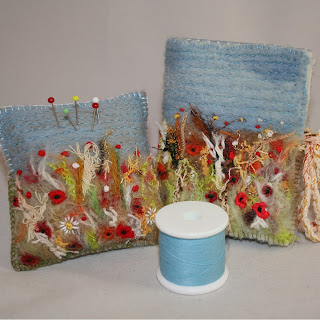.... re-using and, most importantly, re-loving. I feel compelled to use textiles to the full. Of all the materials which might be pressed into landfill, textiles perhaps do less damage than many. My sister-in-law successfully composts items which are totally beyond use! Maybe its more that I would like all the resources used in the production and transportation of the original items to benefit the world to the full. In some cases, its the beauty of the item which I want to preserve - often enhanced, or even acquired, through the aging process.
Perhaps I am also preserving memories. How many of us keep wedding dresses, Christening gowns, baby outfits? I have crazy quilt panels, pieced and awaiting embellishment, made from textiles which have been part of my life for as long as I can remember (about 50 years now!!).
A little barmy, maybe, but I have made a sort of pledge that, with a very few exceptions, all household textiles which have completed the first part of their life-cycle will be re-purposed - nothing is to be placed in the household bin. At the risk of being considered a 'little odd' this is how I have been doing so:
- All items still fit for original purpose - send to charity shops.
- Woolens - knitted or woven - felt (full) and use in craft projects.
- Other Knits - weaving strips, rag rugs, stuffing, cleaning cloths.
- Fleece - patchwork blanket, smaller items eg hats, rag rugs, 'wadding', brooch backing.
- Shirts (and similar) - 'good' patches - used in craft projects, others in weaving (stick/peg/loom), rugs, crochet, knitting.
- T-shirts - rag rugs (hooked, prodded, woven), pin cushion tops, knitting, crochet (storage baskets etc)
- Table Linen - cherish and re-use all decorated bits, otherwise: patchwork, weaving.
- Bed linen - dust sheets, rag rugs...
- Towels - cut down and edge - cleaning cloths.
- Denims - 'Currently stored awaiting experiment'
- Sports socks (actually one of the most useful items - surprisingly!) - wet boot stuffers (wash/dry and re-use), polishing pads (one filled with others)
- Jersey boxer shorts - floor/bike cleaning cloths.
- Any other small items - rag rugs if possible or cut up for stuffing draft excluders, doorstops etc.
Naturally, all off-cuts from my craft work are carefully stored and used. Both my Meadow and Harvest designs use yarn snippets left from other projects (on a background of 'eco' felt - produced from recycled plastic bottles).
This bookmark is my first listing of an item stitched from vintage linens and lace:
I must go for now. I am part way through some stick weaving experiments - re-purposing some shirts. I'll photograph the key stages to show you.


















































